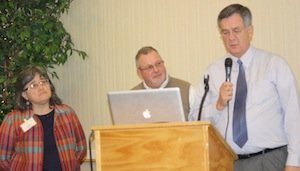
Theory, economics, and practical experience combined when Cornell economist Alison DeMarree, high-density apple grower Rod Farrow, and horticulturist Terence Robinson explained how to profit from precision orchard management.
In two days of classroom instruction led by a dozen Cornell University experts, a vision was laid out for the highly profitable orchard of the future—one that would produce 2,000 bushels of apples per acre per year when mature, would have borne 3,000 or more bushels already by its fifth leaf, and would pack out more than 85 percent high quality fruit—the best, highest value varieties, uniform, high colored, of the best flavor and texture.
The summit was led by Cornell horticulturist Dr. Terence Robinson, a long-time advocate and developer of the tall spindle system and a recent enthusiast of a fruiting wall system maintained by mechanical summer hedging and infrequent dormant pruning. This system is being used in Italy.
The ideal apple orchard, Robinson says, is 11 feet tall, planted in rows 12 feet apart with trees 3 feet apart, trickle irrigated, fertigated, mechanically hedged to four feet thick at the bottom and two feet thick at the top, with most orchard operations—training, pruning, trellising, and harvest—done by crews on platforms.
To get to that ideal, growers need to plant high quality, feathered nursery trees, push them hard with fertilizer and water to grow them tall quickly, tie down branches to induce precocious flower formation, take some fruit already in the second leaf but pay close attention not to overcrop and stunt the trees.
Of 212 people at the meeting, 102 were New York growers, with a large contingent from Michigan, and other growers coming from Ontario, Pennsylvania, Massachusetts, New Jersey, North Carolina, and Virginia.
Many of the growers were already well on their way to converting to tall spindle designs and are making plantings of high value varieties for fresh market. Some are using platforms, getting workers off ladders, and some are using them for harvest.
Robinson noted how growers in the West have been adopting high-density systems, but were using complicated V trellises and tying limbs to wires. While the resulting system can be very precise in training and pruning, and thinning can be very precise to obtain the exact right number of the right size apples on every tree, Robinson thinks those goals can be accomplished with less hand labor and less rigidity, giving each tree more freedom without sacrificing quality.
Starting in the May 1 issue, Good Fruit Grower will begin a series of articles explaining the many precise elements in managing a precision orchard, reporting what was put forth at the Geneva summit.

Leave A Comment